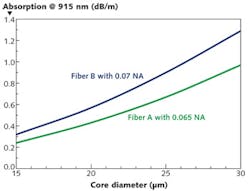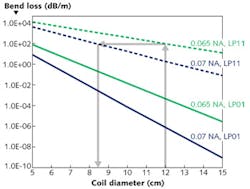KEVIN FARLEY, GEORGE OULUNDSEN, and KANISHKA TANKALA
Fiber lasers and amplifiers have improved vastly over the past decade as improvements in active and passive fibers, diodes, and various fiber-optic components have progressed to mature technology platforms. Fiber lasers capable of high output powers (peak and average powers) while maintaining diffraction-limited beam quality have been made possible by the continued development and engineering of double clad (DC) fibers, and in particular, large-mode-area (LMA) DC fibers. Singlemode (SM) fibers provide diffraction-limited outputs but cannot be scaled for high powers because of their inherent small mode area. Multimode (MM) fibers, propagating tens to thousands of modes, can handle high powers, but offer poor beam quality.
LMA fibers supporting a few modes provide a larger fundamental mode area for power scaling and, with proper selection of the fiber, can provide excellent beam quality. Selecting LMA fibers for a given application requires careful consideration of fiber parameters, desired laser performance, manufacturing costs, and product reliability. This article discusses the fiber choices a laser manufacturer should consider for application-dependent optimal laser performance.
Several LMA fiber options are available to laser manufacturers. Understanding the tradeoffs and performance impacts of the fiber properties and characteristics is important for selecting the most appropriate fiber for the specific application. The choice of an LMA fiber for getting raw output power at the lowest cost but with limited beam quality can be different from an LMA fiber that offers high power with excellent beam quality for a marginally higher cost. Selecting an LMA fiber with high absorption (providing shortest fiber device length) could reduce the overall laser product cost, but these fibers could make it difficult to achieve good beam quality. On the other hand, choosing a fiber with slightly lower absorption may enable excellent beam quality at the highest of powers.
Ytterbium (Yb)-doped fiber absorption depends both on Yb concentration and the overall fiber core composition. Figure 1 shows the cladding absorption, at 915 nm, of two Yb-doped fibers. By maximizing the Yb concentration and compromising on the core composition, Fiber B with 0.07 numerical aperture (NA) can provide 25-30% higher absorption than Fiber A with 0.065 NA. Fiber B will allow the laser manufacturer to use a shorter length of fiber, potentially reducing manufacturing costs.
This may be a sound choice if the application requires a given power output without near diffraction-limited beam quality. However, if the laser requires SM-like beam quality, the fiber should be chosen carefully based on the number of guided modes it supports and how easily the fiber provides excellent beam quality. For a given core size, the number of modes increases with NA. The higher the number of guided modes, the more challenging it becomes to achieve fundamental mode operation.
The normalized frequency, or V#, determines the number of linearly polarized modes determined by the standard formula V=2πaNA/λ, where a is the core radius; NA is the numerical aperture of the core; and λ is the operating wavelength. Figure 2 illustrates the number of modes supported by fibers with different core sizes and NA. As the core NA and/or the core diameter increase, the V# and the modes within the fiber increase. The number of modes supported by commercially available LMA fibers with specific core size and NA tolerances can be determined with Fig. 2.Of modes and NA
In general, the fiber core size is determined by the laser power requirement for the specific application. By choosing lower NA fibers, laser manufacturers can limit the number modes they must manage to achieve the best beam quality. This can be illustrated by considering two 20 (±1.5) μm core diameter LMA fibers with slightly different NAs. Fiber A has an NA of 0.065 ±0.005 while Fiber B has an NA of 0.07 ±0.005. The number of modes supported by Fiber A (green box) and Fiber B (blue box) are depicted in Fig. 2.
It is clear that Fiber A predominantly supports two to three modes (green shaded area) while Fiber B predominantly supports four modes (blue shaded area). This difference in the number of modes can have a significant impact on the ability to achieve good beam quality. Fiber manufacturers who recognize this advantage not only offer Fiber A, but also ensure that the core size and NA of the fibers they manufacture fall within the green shaded area.
In LMA fibers, each of the modes supported by the core can experience gain. By suppressing the gain in the higher order modes (HOMs) the fundamental mode can experience all the gain, delivering a diffraction-limited beam. One of the techniques employed to suppress gain in the HOMs is to coil the fiber.1 For a given coil diameter, the bend loss in the HOMs is greater compared to the fundamental mode. So by choosing an appropriate coil diameter, the fundamental mode loss can be kept small while achieving high loss in the second and other higher-order modes.
The higher bend loss suppresses the gain in the HOMs, sustaining all the power in the fundamental mode. Fibers with fewer modes for a given core size easily enable bend-loss-induced gain suppression of the HOMs. Conversely, the more modes in a fiber, the more stable the HOMs become, requiring tighter coil diameters to induce the required bend loss.
Figure 3 depicts the bending losses of the fundamental mode (LP01) and first higher order mode (LP11) at 1060 nm as a function of the coil diameter for Fiber A (0.065 NA) and Fiber B (0.07 NA). Fiber B supports two additional modes not shown in the figure that have even higher bend losses than the LP11 mode. These additional modes are easily suppressed and are not of primary concern for this example. Examination of bend losses for the two lowest order modes is sufficient to understand the challenge faced by laser manufacturers trying to achieve good beam quality with Fiber B. The seemingly small NA difference of 0.005 between Fiber A and B makes a significant difference in both the bend loss of the LP01 and LP11 modes and the required coil diameter necessary to suppress the LP11 gain.Balancing options
A laser manufacturer using Fiber A, with an absorption of 0.45 dB/m at 915 nm (see Fig. 1), will need ~30 m of fiber to achieve ~13 dB total absorption. With a coil diameter of 12 cm, the bend loss of the fundamental mode is <0.03 dB (30 m at 0.01 dB/m). At the same diameter, the undesirable LP11 mode experiences 3000 dB loss over 30 m of fiber. The high loss ensures significant suppression of the LP11 gain enabling fundamental mode operation and, hence, excellent beam quality.
A laser manufacturer using Fiber B (with 0.55 dB/m absorption) will need only 24 m of fiber to achieve ~13 dB total absorption. For the same 12 cm coil diameter as Fiber A, the bend loss of the undesirable LP11 mode is only 30 dB in Fiber B. The much lower bend loss (100 times lower) of the LP11 mode in Fiber B compared to Fiber A makes it difficult to achieve fundamental mode operation with Fiber B. If laser manufacturers try to achieve this operation in Fiber B, they are forced to use a coil diameter of less than 12 cm. Figure 3 demonstrates Fiber B would have to be coiled to less than 8.5 cm diameter to reach the same LP11 loss as Fiber A coiled to 12 cm.
LMA large-diameter double-clad fibers are stiff, making it challenging and time consuming to properly coil and package, especially to small diameters. Furthermore, the increased stress on the fiber as the coil diameter is reduced will adversely impact the fiber's mechanical reliability.
As fibers are bent to smaller diameters, the tensile strain increases and higher tensile strains can cause early mechanical failures. The tensile strain on a fiber is inversely proportional to the coil diameter. As discussed above, Fiber B must be coiled to nearly 8 cm in diameter to achieve similar beam quality as Fiber A coiled to 12 cm in diameter. The resulting tensile strain on Fiber B will be 50% higher than on Fiber A. The fiber coil diameter is an important consideration since fiber lasers are designed to last for thousands of hours and the strain induced by coiling is a constant force on the fiber.
If the strain is large enough, over time it can cause mechanical failure of the fiber; therefore, minimizing strain on the fiber is important to ensure good laser reliability. Maintaining coil diameters as large as possible helps improve mechanical reliability of the fiber and prevents catastrophic failure of expensive laser components and the laser itself during operation. Selecting Fiber A not only makes it easier to achieve excellent beam quality, but also helps ensure good laser reliability.
While the foregoing discussion focused on a 20-μm core fiber, a similar approach can be taken for selecting fibers with larger core sizes. Figure 4 shows that near diffraction-limited beam quality can be achieved in a 25-μm-core, Yb-doped fiber by following the same fiber selection process discussed in this article.Fiber lasers are becoming the choice for many industrial applications such as marking, micromachining, cutting, welding, drilling, and engraving. While raw power with poor beam quality may be adequate for some applications, there is currently great interest in high-power fiber lasers with excellent (SM) beam quality. Laser manufacturers have several LMA fiber options to choose from. High powers can be achieved at somewhat lower costs by selecting fibers that maximize absorption. However, if excellent beam quality along with high power is desired, laser manufacturers must carefully select among available fibers. A discerning choice will ultimately offer the best cost-performance benefit for the targeted application.
REFERENCE
1. J. P. Koplow, D. A. V. Kliner, and L. Goldberg, Opt. Lett., 25, 442-444 (2000).
Kevin Farley, Ph.D., is scientist, George Oulundsen, Ph.D., is fiber product line manager, and Kanishka Tankala is vice president, fiber business at Nufern, 7 Airport Park Rd., East Granby, CT 06026; www.nufern.com.



